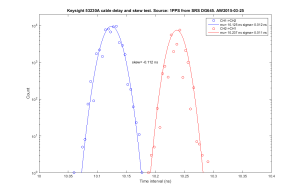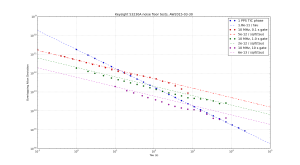We got a new 53230A counter to the lab, so I decided to run some basic tests on it.
I collected time interval data using a 1-PPS source (H-maser through a SRS DG645), and wired this with a T-connector from CH1 to CH2 with a ~1 m (10 ns delay) cable. This should show the noise floor for time interval measurements as well as CH1/CH2 timing skew when measured the other way around (i.e. from CH2 to CH1). The 10 MHz external reference (at the back) was connected to a H-maser.

The results show standard deviations of 12 ps (CH1->CH2) and 11 ps (CH2->CH1) respecively, with a channel skew of 112 ps. Compare to the single-shot spec of sqrt(2)*20 ps = 28 ps and Agilent/Keysight's marketing video on youtube.
I also collected 10 MHz frequency counter readings on CH1 (source: H-maser) with gate times of 0.1 s, 1.0 s, and 10.0 s. I collected the data with a simple program that just calls the "READ?" function repeatedly, which does result in some dead-time between measurements.
Here are the results in terms of Allan deviation. I used allantools.
The time interval noise floor looks like white phase noise with an Allan deviation of 1.8e-11/tau. This is consistent with the 12 ps RMS value found above. It is left as an exercise for the reader to show that ADEV(1s) = sqrt(3)*RMS-time-interval-noise (correct??).
The frequency counting noise floor depends on the gate time, and I get 5e-12/sqrt(tau), 2e-12/sqrt(tau), and 6e-13/sqrt(tau) for gate times of 0.1 s, 1.0 s, and 10.0 s, respectively. This looks like white frequency noise. Enrico Rubiola has notes on frequency counters that may explain the numbers.

Hi, were you using "READ?" command when you collected the time interval measurements too?
Hi, with READ? and a 1PPS signal I think you end up measuring every second pulse, because the command takes so long to execute. However there should be no internal averaging or other strange stuff going on, so in that sense READ? in time-interval mode is just fine.
I have some scripts for continuous 1PPS time-interval measurements - I can post them here later if you are interested. At least they work when the time-interval is small (e.g. 100ms) compared to 1s. There could be problems with long intervals, e.g. 900ms, and I didn't optimize the script for that.
Hi, I know this been a while since you wrote this, but did you find that example for continuous 1PPS measurements? 🙂
This is what I got now:
counter.write("CONFigure:TINTerval (@1),(@2)")
counter.write("SENSe:GATE:STARt:DELAy:SOURce IMMediate")
counter.write("SENSE:TINTerval:GATE:SOURce IMMediate")
counter.write("SENSE:TINTerval:GATE:POLarity POSitive")
+ ...some level setup...
Then while True: counter.ask("read?")
Thanks
Hi Anders,
We use something very similar for 1PPS measurements. I tried a few different ways (the manual has 'fetch' etc. commands) but the simple READ? way seems to work OK for 1PPS.
Mostly our 1PPS signals are quite well aligned, so this code may have some problems if you want to measure >900ms time intervals routinely.
I posted a gist on github: https://gist.github.com/aewallin/cd13121f89b2d4d04dc011113b686d17